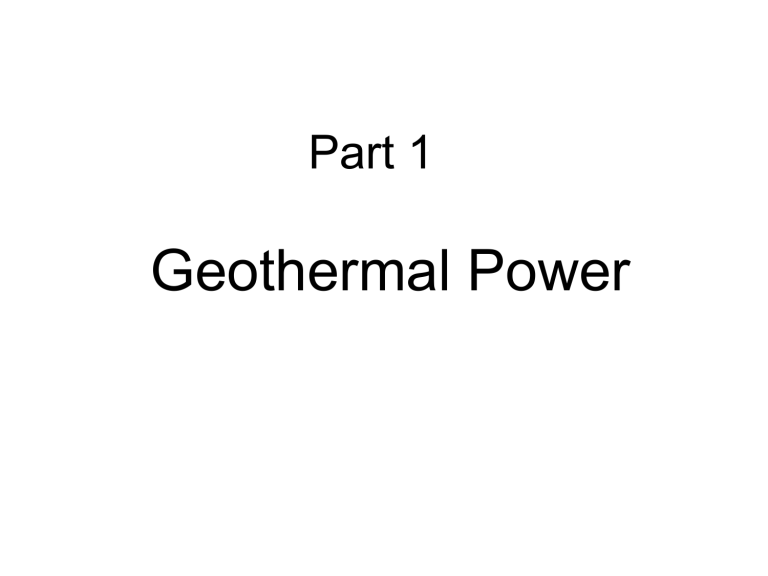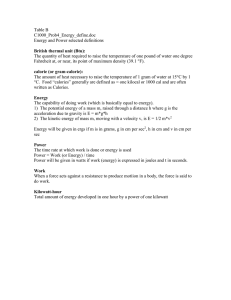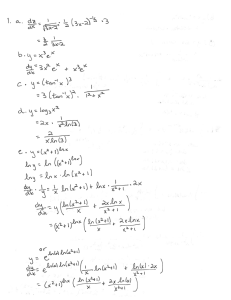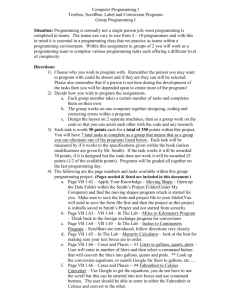Lecture 19: Geothermal Power

Part 1
Geothermal Power
Why?
Growing demand for energy
Concern about CO
2 from fossil-fuel burning
Recent Report, The Future of Geothermal
Energy , gives favorable assessment
Indian Point Power Plants 1 and 2, big energy producers in the NY City area
Electric Power Primer
Typical Big Power Plant generates 1GW
One billion watts … 10 9 J/s of energy
In a year it generates
10 9 J/s x 3.1x10
7 s/year = 3.1x10
16 J/year
A nice round number is 10 18 J
That’s the amount of power a 1GW plant
Generates in its nominal 30-year lifetime
US Electrical Power Production
Capacity
906 GW in 2006 rate of increase 1% per year about 1000 big power plants need 10 new ones each year
An aside … controversial Cape Wind project offshore Cape Cod would generated
0.4 GW by 120 turbines
Offsets growth of New
England power demand for about a year or two …
Geothermal lumped into
“Other Renewable” … not much!
Where is the Heat?
Typical Geothermal Gradient: typical region: 20 K/km volcanic region: 100 K/km
Power production needs temperatures well above 100 deg-C
So drilling needed to access heat
3.5 km – easy to drill, but not very hot
What’s that hot spot?
Yellowstone Caldera
Biggest Volcano in US here I am standing by Old Faithful above 10,000 cubic km of magma
6.5 km – expensive but routine, areas of western US are hot
10 km – very hot, but pushing limits of technology
Heat in Rock: Q = r
Cp V
D
T
Heat = density * heat capacity * Volume * change in Temperature
Density = 2500 kg/m 3
Heat Capacity = 1000 J/kgK
Volume = 1 cubic km = 10 9 m 3
D
T = 100 K
So Q = 2.5 x 10 17 J
A 1 GW power plant generates 3.1x10
16 J/year, so this is about tens years of a 1GW power plant
Remember 10 18 J is roughly the amount of energy produced by a power plant in its nominal 30 year lifetime, so these estimates indicate a huge supply of heat energy
How to access heat?
Drill 2 holes, one to inject cold water, another to extract hot water
Circulate fluid
Use hot water to generate steam that turns turbine of more-or-less standard design
Issues
Drill 2 holes … expense of drilling
Circulate fluid … low permeability of rock
Generate steam … dissolved minerals in water
Money Counts!
Any sort of mining or extraction is an
Economic Activity that competes by price against alternatives
If the economics are not right
It will not be done even if it is in theoretically possible to do
Solution to low permeabiliy
Artificially increase permeability by creating fractures
“Hydrofracture” … pressurize well until you crack the surrounding rock, routinely used in oil extraction, at least for small volumes of rock
60 MW Krafla power plant, Iceland: heat from 33 wells drilled into volcano
Tiny by US standards Lots of wells
Power plant
Magma chamber
Part 2
Fresh Water
Possibly the most
Limiting Resource
How much water do you use in a day?
US Water Usage, %
Public Supply
Domestic Supply
11
1
Irrigation
Livestock & Aquaculture
Industrial
Mining
34
2
5
1
Thermoelectric Power 48
US Water Usage, billion gallons / day
Public Supply
Domestic Supply
27.3
0.6
Irrigation
Livestock & Aquaculture
Industrial
Mining
80
3.4
14.9
1.2
Thermoelectric Power 135
Total 262
Ogallala Aquifer
US Water Usage, billion gallons / day
Public Supply
Domestic Supply
27.3
0.6
Irrigation
Livestock & Aquaculture
Industrial
Mining
80
3.4
14.9
1.2
Thermoelectric Power 135
Total 262
Total 262 billion gallons/day
362 cubic kilometers per year
H
2
0
7 km
Public & Domestic Supply
27.9 billion gallons/day
266 gallons per person per day drinking cooking & washing dishes washing clothes flushing toilet
Cooling water for power plants
135 billion gallons/day
450 gallons per person per day
40 kWh average daily electrical consumption per person in US
So 0.08 kWh per gallon a gallon lights the bulb for an hour
Irrigation
80 billion gallons/day
266 gallons per person per day
2750 calories average daily food consumption per person in US
So 10.3 calories per gallon
2.7 calories per liter a gallon gets you a chip
Wheat: 3500 calories/kg
Wheat: 4.6 calories/liter
About 750 liters of water to grow a kilogram
Rice: 3700 calories/kg
Rice: 2.4 calories/liter
About 1550 liters of water to grow a kilogram
How much irrigation water does the world need?
2000 calories/day minimum
At 3 cal/liter
670 liters/day
6 billion people
365 days/year
= 1.46 10 15 liters/year
= 14700 cubic kilometers per year
So how much is available ?
The
Hydrologic
Cycle
108,000 km 3 /year precipitated on land
62,000 km 3 /year evaporated from continental reservoirs
46,000 km 3 /year runoff to oceans
46,000 km 3 /year transported on shore
Need 14,700 km 3
Available 46,000 km 3
So superficially about three times as much water is available than is needed.
But consider …
Some runoff is in uninhabited regions
Runoff is uneven during the year and may be lost to sea before it can be used
The rest of the biosphere uses water, too
Human populations are growing
Runoff is uneven during the year and may be lost to sea before it can be used
Solution – Reservoirs (“Impoundments”) created by damming rivers
Global impoundments of water
8400 km 3
Not much growth in last decade, except in Asia-
Australia
Regional distribution of large dams
Dams in the US. Note that the red symbols indicate high hazard potential. Dam maintenance has not been a high priority for many municipalities and other dam owners.





